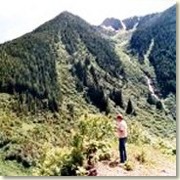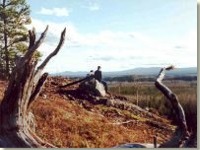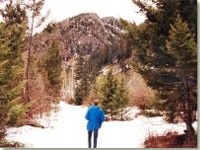What to do when you are lost
 It happens to the best of us. You are enjoying a marked trail, and decide to go a little further than you should into the unmarked woods. Maybe you misread a map or your compass settings, and wind up going the exact opposite way than you should. And all of a sudden, you find yourself in an unfamiliar setting, with no idea how to get home. That’s right, you’re LOST!
It happens to the best of us. You are enjoying a marked trail, and decide to go a little further than you should into the unmarked woods. Maybe you misread a map or your compass settings, and wind up going the exact opposite way than you should. And all of a sudden, you find yourself in an unfamiliar setting, with no idea how to get home. That’s right, you’re LOST!
Hundreds of people each year get lost in British Columbia’s wilderness. Most of them make it back home alright. But what would you do if it happens to you? Most people get into trouble and/or get lost when not prepared. I have searched for a number of people who have become lost. (Just about all of them were not prepared). It is surprising how many people get lost by just leaving their car and heading into the bush a short distance away, only to get completely turned around and be lost within a matter of minutes, or by just leaving a main hiking trail for a short distance.
The best thing you can do to prepare for getting lost is to let somebody know where you are going. Make sure before you set off for the bush that you leave a hike plan including where you are going and when you are returning. Then make sure you stay with the plan. That way, someone has a general idea of where you are going.
The most important rule in the bush is, when in doubt, or if you think you are lost, sit down and think. The best thing that you can have in situations like these is a clear head. Do not panic, but try to look at your surroundings. They may help you get your bearings, allow you to retrace your steps, and set you back on a right course again. If you find that this does not help, take a few deep breaths. Look at the trees, the sky, the lovely scenery, and concentrate on the beauty of your location for a while. Then, pull out your map and compass and try again.
If you believe that a search party will be out looking for you, and you have some supplies, you may want to consider staying put, and letting the search party find you. Help your searchers to find you by using smoke from a fire, using a signal mirror, or, if you must move to find shelter, consider leaving a note describing where you are going or directional markers to help people find your new location.
 However, what if a search party is not likely to be looking for you, or you are in a situation where you need to find your way back as soon as possible?
However, what if a search party is not likely to be looking for you, or you are in a situation where you need to find your way back as soon as possible?
The first thing you should do is to determine where north, south, east and west are. The easiest way to do this is by using your compass. Take out your compass and determine north and south and lay a stick in a north south direction or mark it in the ground. If you don’t have a compass, look at the sun and determine where you are approximately. You know that around noon the sun should be the highest, so determine approximately where north is. (The sun rises in the east and sets in the west)
If you don’t have a compass and it is a cloudy day you have to go by the hints given by the land. You know that the southern slope gets the most sun. This is where the game feeds in the wintertime. Everything is brighter on the southern side than on the northern side. In dense bush you will find moss growing on the north side of a tree. Hills will have more grass and less snow in wintertime. There are lots of little hints that will tell you where south is by the terrain. Creeks and rivers - remember that British Columbia has the Rocky Mountains on one side and the coast range on the other side. The Fraser River and the Thompson River run down into Vancouver. The Skeena River and the Bulkley River run out into Prince Rupert. All rivers and creeks run into these major systems. It should give you an indication of which way the water system is draining and will give you some idea where north and south is.
Once you have determined where north/south is, try to remember where you came from. If you have a map locate yourself approximately. Analyze which is the easiest way out. And this is not always going back to where your vehicle is parked. Sometimes you are closer to a main road and it is better going to that than circling back through the bush. Once on the main road you can possibly get a ride back to your vehicle or walk.
 To find a way out, you can cover the surrounding area looking for recognizable landmarks, or signs of your trail into the area. If you have a compass, take a reading in the direction you think your trail is, and then start out. Make sure you mark your trail on the way out- overturn large rock, use red tape on tree trunks, or, in extreme cases, blaze your trail by marking large trees with your knife or break off tree branches. Once you have exhausted the possibility of finding the trail or road, follow your trail back, and repeat in the opposite direction.
To find a way out, you can cover the surrounding area looking for recognizable landmarks, or signs of your trail into the area. If you have a compass, take a reading in the direction you think your trail is, and then start out. Make sure you mark your trail on the way out- overturn large rock, use red tape on tree trunks, or, in extreme cases, blaze your trail by marking large trees with your knife or break off tree branches. Once you have exhausted the possibility of finding the trail or road, follow your trail back, and repeat in the opposite direction.
Listen for sounds - cars on highways, railroads, human voices. Sound carries a long way in the bush, so stop and listen. Look for signs like smoke curling, which can mean a fire from a campsite or a cabin.
In a situation where you will need to set-up camp, make sure you stop about ½ hour before dark to give yourself time to set up a shelter, make a fire for the evening, and gather enough firewood to last you the evening.
Always keep your head. If you do not panic, and you follow the hints of nature, you will make it back to civilization in one piece.
Contact Information: #200 - 313 Sixth Street, New Westminster, BC V3L 3A7 CANADA
Telephone: 604-606-7900 | Email: [email protected]
Copyright © 2012 Niho Land & Cattle Company. All rights reserved. | Privacy Policy | Terms of Use | Webmaster

